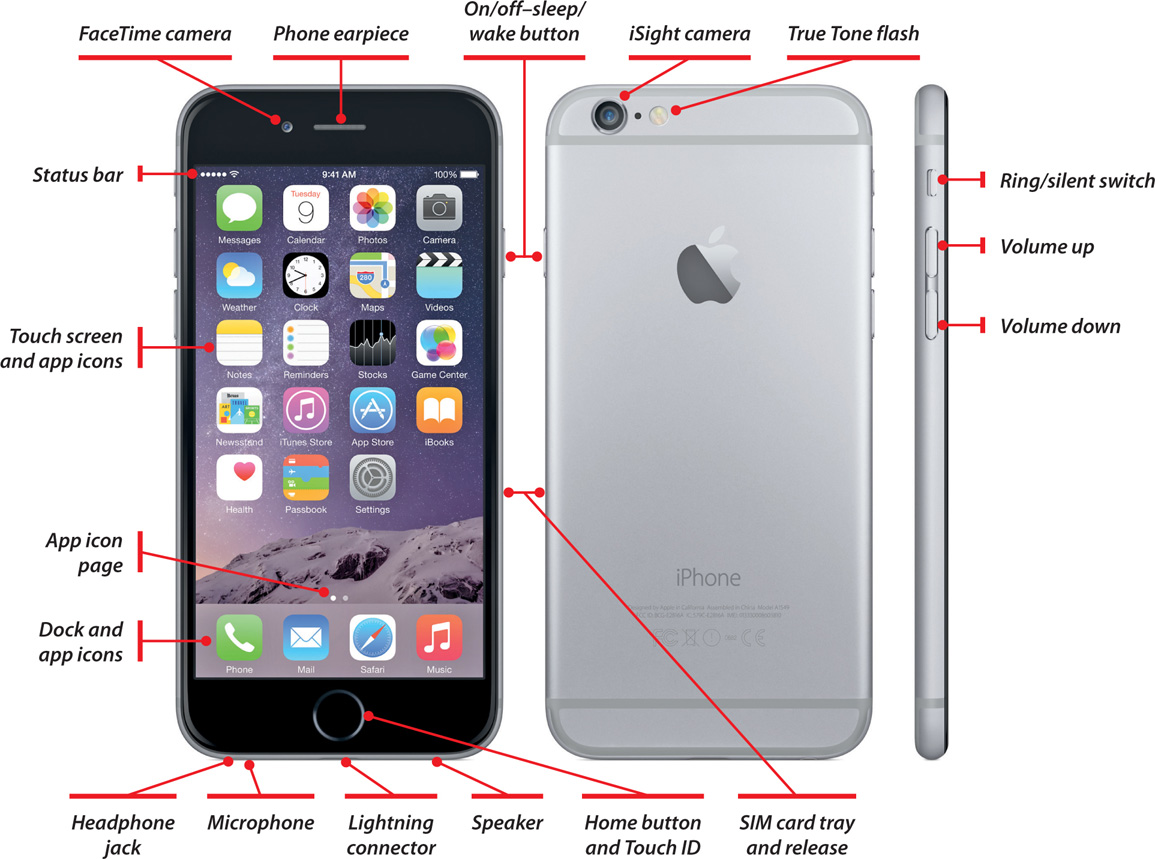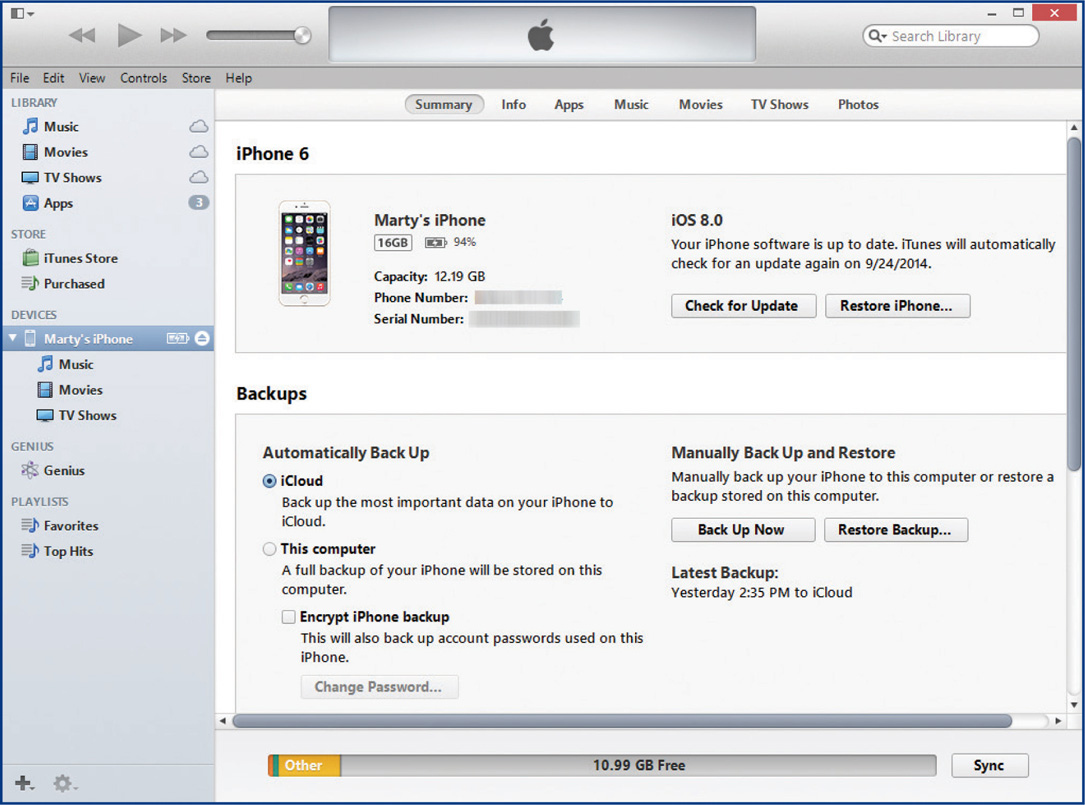Chapter 1
Getting Acquainted with Your iPhone
QuickSteps to…
![]() Look at the Physical Features of the iPhone
Look at the Physical Features of the iPhone
![]() Plug In and Charge Your iPhone
Plug In and Charge Your iPhone
![]() Turn On and Set Up Your iPhone
Turn On and Set Up Your iPhone
![]() Attach Your iPhone to a Computer
Attach Your iPhone to a Computer
![]() Turn Your iPhone On or Off and Put It to Sleep or Wake It
Turn Your iPhone On or Off and Put It to Sleep or Wake It
![]() Get Accessories for Your iPhone
Get Accessories for Your iPhone
Welcome to your iPhone! It is one of the foremost communication and information devices ever created. It allows you to communicate through voice, video, and text, as well as seek information in the form of text, sound, images, and video. You can make and receive any of the three forms of communication, as well as create, access, and exchange information on the Internet—through email, notes, or documents you write; through photos or video you take; and through appointment calendars, maps, and games you use. Your iPhone even provides a built-in voice-activated assistant to help you use it and its information. In addition to what you see on the screen when you first start your iPhone, there are over 1.2 million “apps” (applications) you can download from the App Store and run on your device.
The iPhone 6, shown in Figure 1-1 in the next section, is first and foremost a phone with which you can call any other phone in the world that’s on a public exchange. It is also a fully capable handheld computer, not much different from a desktop or laptop computer except in size and shape. Although there are some limitations due to its size, such as a smaller screen and less memory, this is more than made up for by its cameras, its global positioning system (GPS), its ability to use cellular as well as a Wi-Fi Internet connection, and its considerable portability.
Figure 1-1: Front, back, and side of the iPhone 6 (courtesy of Apple Inc.)
NOTE This book is written with the iPhone 6 or 6 Plus and iOS 8. There are many similarities with iPhone 5s, 5c, 5, and 4s and iOS 7, so this book can easily be used with earlier devices. However, I strongly recommend upgrading to iOS 8.
In this chapter you’ll explore the external features of the iPhone, see how to plug it in, charge its battery, turn it on and off, put it to sleep, and wake it up. You’ll then go through the iPhone setup to get an Apple ID and activate your iPhone and set up its basic services.
![]()
TIP Sign up for the AppleCare+ two-year extended warranty in the first 30 days and get two instances of accidental damage coverage, plus two years of telephone support, versus no accidental damage coverage and 90 days phone support in the free basic one-year warranty. The extended warranty currently costs $99 plus tax.
EXPLORE YOUR IPHONE
Take a moment to explore the physical iPhone and what you got when you purchased it.
 Look at the Physical Features of the iPhone
Look at the Physical Features of the iPhone
Your iPhone has several controls, sockets, and features that allow it to perform its functions. These are located on the front, back, and sides of the device. Figure 1-1 shows the front, back, and left side of an iPhone 6, which contains these components:
• FaceTime camera This camera has 1.2MP (megapixels, or million pixels) resolution, provides face detection, and takes 720p (progressive-scan) high-definition (HD) video. It is used with FaceTime, the video-conferencing app that comes with the iPhone, but can also be used with other apps. See Chapter 6 for how to use FaceTime.
• Phone earpiece Used to hear a phone conversation.
• On/off–sleep/wake button The primary power controller for the iPhone. Pushing it quickly puts the iPhone in power-saving sleep mode. Pushing it quickly again or pushing the Home button wakes the iPhone from sleep. Pushing and holding this button for about three seconds begins the process of shutting the power fully off. Pushing and holding this button for a little over a second when the iPhone is powered off begins the process of powering up the iPhone.
• iSight camera This camera has 8MP resolution with autofocus, optical image stabilization (iPhone 6 Plus only), a five-element lens, face detection, exposure control, backside illumination, and panorama mode. It can be used for either still pictures or videos with video stabilization, continuous autofocus, 3× zoom, and 1080p HD. See Chapter 6 for more information on using the camera.
• True Tone flash Provides a bright light for the camera when the light sensor between the camera and the flash says it is needed. The flash can also be used as a flashlight that is turned on from the Control Center.
• Ring/silent switch Turns off the ringer so that the phone only vibrates if it rings. You can use Settings | Sounds to set the ringtone used and to set when the phone vibrates.
• Volume up/down buttons Used to change the loudness of the phone ringer and in both the speaker and whatever is plugged into the headphone jack. Press the top button to increase the volume and press the bottom button to reduce it.
• SIM card tray and release hole You can poke a paperclip into the release hole to open the tray. The tray holds the SIM card, which identifies your phone, your network, and type of service. It normally comes already installed.
• Home button and Touch ID Used to display your Home screen when pressed. From the Home screen you can open or reopen any app on the phone and access the settings that control how the iPhone behaves. In the iPhone 6 and 6 Plus, as well as the iPhone 5S, the Home button incorporates a fingerprint identity sensor that you can use to identify yourself in place of entering a passcode.
• Speaker Lets you hear Siri, music that is being played, and other sounds that are produced by your iPhone.
• Lightning connector Used to plug in the iPhone to both charge the battery and directly communicate with another computer.
• Microphone Used to talk on the phone and to Siri (the voice assistant), and used with Voice Memos, FaceTime, and other apps.
• Headphone jack Used to plug in headphones, such as Apple’s EarPods, to talk on the phone, listen to music, and hear any other audio, including Siri, produced by your iPhone. When a listening device is plugged in, the iPhone’s speaker and mic are turned off.
• Dock Located at the bottom of the screen, the dock provides a separate area to park your most heavily used apps so you can more easily reach them independent of what other apps are displayed. You can move apps on and off the dock, but it is limited to four apps.
• App icons Represent the applications available on the iPhone. You start out with apps that come standard with the iPhone and in a standard layout. You can add icons and rearrange their layout on the screen, but you cannot delete the standard apps. (However, you can hide the standard apps by enabling Restrictions in Settings | General and turning off the apps you want hidden.)
• App icon page The dots shows which of the several app icon pages is being displayed. Two dots with the first one brighter than the other one means that there are two app icon pages and the first one is being displayed.
• Touch screen Also called a “multitouch screen” or just “the screen,” the touch screen comprises the majority of the front face of the iPhone. It allows you to view, select, and manipulate the contents displayed there.
• Status bar Located at the top of the iPhone screen, the status bar provides information about the connectivity with both Wi-Fi and your cellular carrier, the current time of day, and the degree to which your battery is charged (described in Chapter 2).
Use of iPhone Memory
Inside your iPhone is memory that is used to store pictures, movies, videos, TV shows, music, books and magazines, mail, contacts, documents, and apps. Apps can also temporarily use some memory when they execute. No two people will have the same mix of these items, and there is no easy way to determine what your mix will be. Also, no one item takes the same amount of storage in every device. You have at least 16GB (gigabytes, or billion bytes) of memory and maybe more, depending on the model you have. Here are some rough rules of thumb for the amount of memory used by various items:
• Full-length commercial movies and TV shows are 1GB to 3GB.
• Videos, depending on their length and their format, take from 500MB (.5GB) to 1.5GB.
• Music takes about 1MB per minute, or about 50MB for a CD.
• Magazines depend on length and the number of photographs, but generally range from 150MB to 500MB.
• Pictures, depending on their size and quality, take from 50KB to 3MB.
• Apps vary greatly, from 50KB to over 1GB for some games.
• Documents, mail, and contacts take relatively little space.
NOTE A kilobyte (KB) is 1,000 bytes, 1,000KB is a megabyte (MB), and 1,000MB is a gigabyte (GB). A byte is roughly a character.
As you store information on your iPhone, consider your mix of movies, TV shows, music, and games. If you are around a computer where you can store these items, it is very easy to transfer items back and forth from your iPhone. You can also use iCloud for this purpose. Both of these processes are discussed later in this book.
![]()
TIP Store the bulk of your movies, videos, pictures, and music on your computer or on iCloud and only keep on your iPhone what you know you will be using in the near term.
Understand Wi-Fi vs. Cellular
Your iPhone has both cellular and Wi-Fi service capability, which allow the iPhone to connect to the Internet to communicate with the hundreds of millions of people, businesses, organizations, and institutions connected to it. This communication capability is foundational to the use of both the iPhone and its operation. The iPhone could not do what it does without this capability, which is therefore critical to its success.
If you don’t already have Wi-Fi service in your home and/or office, it is easy to get from your local telephone company, TV cable company, or an independent Internet service provider. Also, it is available for free in many public locations such as libraries, coffee shops, hotels, and airports. Depending on your cellular contract, Wi-Fi might be able to save you money.
![]() QuickFacts
QuickFacts
Reviewing What You Need
To use your iPhone, you will need (if you don’t already have) the following:
• A cellular phone account with one of the major providers. In the United States, these include Verizon, AT&T, Sprint, and T-Mobile.
• Wi-Fi wireless Internet connection in your home and office.
• An Apple ID to register your iPhone and download apps from Apple or to get iCloud or iTunes accounts. You will see how to get an Apple ID later in this chapter.
• Access to another computer (either a Mac or a PC and either a desktop or laptop) that you can connect the iPhone to using a USB connection on the computer and the Apple Lightning–USB cable. If the computer is a Mac, it must be running OS X version 10.6.8 or later. If the computer is a PC, it must be running Windows XP (with Service Pack 3 or later) or either 32-bit or 64-bit Windows Vista, Windows 7, or Windows 8. On this computer, you’ll need to have (or download for free) iTunes 11.4 or later.
• Access to a printer with wireless printing capability, such as Apple’s AirPrint. (A printer is not essential, but may be nice to have.)
PLUG IN AND START THE IPHONE
When you first get your iPhone, the temptation is to immediately turn it on and start using it. The iPhones are shipped from the factory with enough charge in their battery to do this, but unless you had your iPhone set up at the store where you bought it, you must go through the activation and setup process. To make sure you have enough power to do all you want when you first turn it on, I recommend that you start by plugging in and charging your iPhone; it should not take more than a couple of hours. After that, you can turn it on and begin the activation and setup process.
 Plug In and Charge Your iPhone
Plug In and Charge Your iPhone
Plugging in your iPhone is not exactly rocket science, but there are two ways to do it:
• The simplest and surest way to plug in and charge your iPhone is by using the USB-to-AC adapter, plugging it into a wall socket, and plugging the Apple Lightning-to-USB cable into both the AC adapter and your iPhone.
• You can also use the Apple-to-USB cable to connect your iPhone to a computer through a USB socket on the computer. This allows you to both charge your iPhone and to transfer information between your computer and your iPhone, as discussed later in this chapter and in several other places in this book. To charge your phone, your computer may need to be turned on.
When you have successfully charged your iPhone and have turned it on, you will see an icon in the upper-right corner of the iPhone screen that looks like a green battery with a lightning bolt to its right.
![]()
 Turn On and Set Up Your iPhone
Turn On and Set Up Your iPhone
When your iPhone battery is reasonably charged, turn the iPhone on and begin the activation process by activating your cellular service, and then go through the setup and activation process of the iPhone itself with Apple.
Activate Your Cellular Service
In the United States, four cellular companies offer iPhone service, and there are slight differences among the services concerning what you have to do to activate your cellular service. Your phone should come with instructions on how to do this, but the easiest and least troublesome way is to call customer service or go into an Apple store or a store for your cellular company and have them walk you through the process.
![]()
CAUTION! If you are replacing an old phone with your iPhone 6, be sure to back up your old phone to your computer before you activate your new phone. This requires that you have iTunes on your computer, or that you use a service provided by your cellular company. Often, you can take your old and new phones into a store for your cellular company and they will back up and transfer the data from your old phone to your new one. You will need to turn off your old phone before you activate the new one.
Activate Your iPhone
When you are ready, use these steps to start and activate your iPhone:
1. Hold your iPhone in portrait fashion, where it is taller than it is wide, with the Home button at the bottom, as shown in Figure 1-1. This will orientate the iPhone for the following steps.
2. Press the Home button at the bottom of the phone. The screen should come on and display the word “Hello” in a number of languages.
If the screen does not come on, press and hold the On/Off–Sleep/Wake button on the right side of the iPhone for several seconds. The screen should display the Apple logo for several seconds as the iPhone starts up (“boots up”). Finally, you should see the initial screen with the word “Hello.”
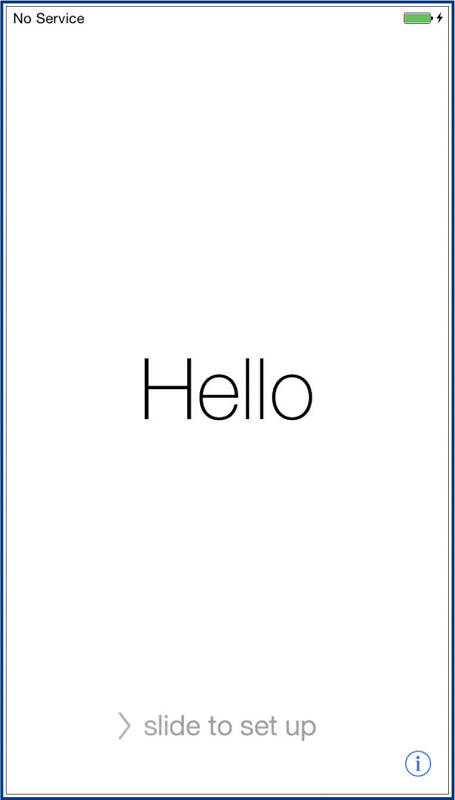
3. At the bottom of the screen, use your finger to slide the words Slide To Set Up to the right.
4. If you are asked to choose your language, touch (or tap) the language you want to use and your country (for example, “English” and “United States”).
5. If there are several Wi-Fi networks around you, you will see them listed. Tap the network you want to use. If you don’t see a network, none is available where you are. Tap Use Cellular Connection and skip to step 7. If you think you have Wi-Fi, contact your Internet provider or ask the business or organization you think is providing the Wi-Fi.
6. If you are connecting to a Wi-Fi network, you are asked to enter the password for that network. Use the onscreen keyboard that pops up to do this (see the “Using the Onscreen Keyboard” QuickFacts later in this chapter) and tap Join.
7. When a check mark appears next to the network you want, tap Next.
8. Determine whether you want to enable Location Services. This uses the iPhone’s GPS and/or your cellular network to determine your current location, and is valuable when you are asking Siri about the location of restaurants or using maps. It is especially valuable when you are getting driving directions. Also, Location Services must be enabled to use Find My iPhone. On the other hand, apps can see where you are and use that information, which you may or may not want. (Keep in mind that you can turn off Location Services for specific apps in Settings | Privacy | Location Services.) I think that the benefits of Location Services outweigh the perceived loss of privacy. Based on your decision, tap either Enable Location Services or Disable Location Services and then tap Next.
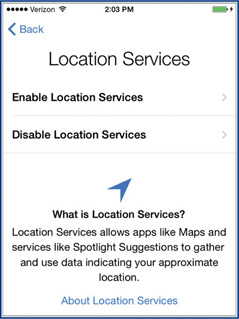
Set Up Your iPhone
With your iPhone started and connected to the Internet, you next need to connect to Apple to set up an Apple ID and register your iPhone. Apple uses a common ID and password for Apple itself, the iTunes Store, the App Store, iCloud, the iBook Store, and the Mac App Store. This allows you to get accounts to download apps from Apple’s App Store, or music and videos from the iTunes Store, and accessories from the Apple Store. You’ll need to have and use an Apple ID even for free apps and other free items. Apple doesn’t charge for the ID itself, and there is no other way to work with Apple. Continue with these steps to set up your iPhone:
1. If you have used an iPhone in the past, you probably have a backup you can use to quickly set up a new iPhone. In that case, your first question is, do you want to set up as a new iPhone or do you want to restore from an iCloud or iTunes backup? If you don’t have a backup, you won’t see this question. We’ll assume you want to set up as a new iPhone (we’ll talk about restoring in Chapter 10). Tap Set Up As New iPhone unless you have the choice of restoring and want to do that.

2. You are then asked to either sign in with an Apple ID or create a new one. Again, we’ll assume you need to create a new one (if you have an Apple ID, enter it and your password and skip to step 11). Tap Create A Free Apple ID.
3. Select your birthday by using your finger to move the three calendar elements up or down. When you are done, tap Next.
4. Tap in the First Name field and tap or type your first name using the keyboard at the bottom of the screen. See “Using the Onscreen Keyboard” QuickFacts later in this chapter to understand how to do that.
5. Tap Return to go to the next line. Type your last name and then tap Next.
6. If you have an existing email address, accept that default, tap Next, enter your address, tap Next again, and skip to step 8. If you do not have an email address that you want to use, tap Get A Free iCloud Email Address, tap Next, and follow on to step 7.
7. Type the first part of your new email address (for example, type funnyclown for an email address of [email protected]). Tap Next. You are asked if you are sure you want to use that email address. If so, tap Create.
8. Enter and verify a password that’s at least eight characters long and contains a number and both uppercase and lowercase letters. Tap Next when you are done.
9. Choose three security questions, enter their answers, and tap Next. If you wish, and if you have one, enter another email address that can be used in case all else doesn’t work. In any case, tap Next.
![]()
CAUTION! Write down your password and the answers to your questions so there is no way you would not know them. Make and keep a password list for yourself and give someone you trust a copy. If you are locked out of your iPhone, no one, not even Apple, can get you in without losing all the information on your phone.
10. If you want email updates from Apple, leave the default ON and tap Next. If you do not want these updates, swipe (move your finger across) the ON button from right to left to turn it off. Tap Next.
11. You are asked if you agree to Apple’s terms and conditions. You can read them on your iPhone or have them sent to you by email. If you don’t agree, you will not be able to use your iPhone. However, if it is shortly after you purchased it (within 30 days), Apple will allow you to return the iPhone with a full refund. When you are ready and do agree, tap Agree and then tap Agree again.
12. Next you are asked if you want to use iCloud, which is Apple’s free Internet storage service for backing up the information on your iPhone. If something happens to your iPhone, you can recover your information from iCloud. Also, if you store your iPhone information on iCloud, you can access that information on your iPad, iPod touch, or Mac. I think it is a good idea, and the first 5GB are free. If you want this, tap Use iCloud; if not, tap its alternative, and then, in either case, tap Next.
13. You are told that Find My iPhone is automatically enabled with iCloud, although you can turn it off later in Settings | iCloud, which is discussed later in this book. Find My iPhone is invaluable if you lose your phone or if it is stolen. Find My iPhone is good insurance, and I recommend that you keep this. Tap Next.
14. Next you are asked if you want to upgrade to iCloud Drive, which is similar to GoogleDrive and Microsoft’s OneDrive. Tap Not Now. We’ll come back to this topic later in the book. Tap Continue to confirm that you do not want to upgrade to iCloud Drive.
15. If you have used an iPhone before, you will be asked if you want to let people contact you via iMessage and FaceTime, and your phone number and email address will be displayed and selected (with a check mark). If you don’t want to use either of those contacts, tap them to deselect them. In any case, tap Next.
16. Next you are asked if you want to use your fingerprint in place of your passcode. If you don’t want to do that, tap Set Up Touch ID Later and skip to step 17. Otherwise, place your finger or thumb on the Home button. Repeatedly lift and replace your finger on the button. When you are asked, lift, move your finger a bit, and replace it to capture the edges of your finger. Finally, you are told that the process has been completed. Tap Continue.
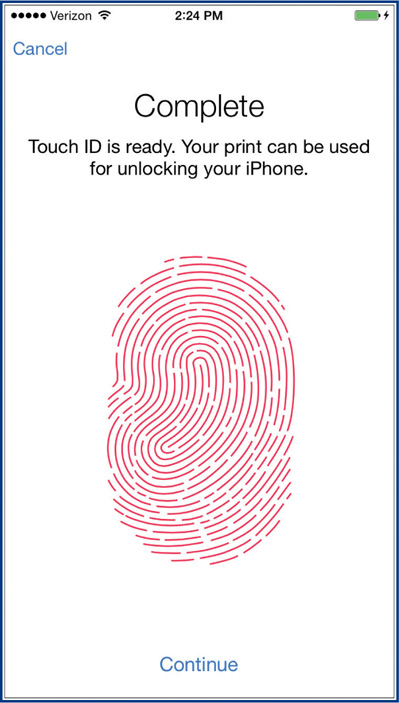
17. You are then asked to create a passcode. Even with Touch ID, a passcode is occasionally necessary for verification. Without Touch ID, a passcode is used whenever you start or wake up your iPhone to protect it from unauthorized use, and I recommend that you set one up. The standard passcode is four numbers, like the PIN you might have elsewhere. Enter your passcode and then re-enter it for confirmation.
18. Next you are asked to set up an iCloud Keychain that is used to store your passwords and credit card information with encryption. You can choose to do this or set it up later. I recommend that you go ahead and do this. Tap Set Up iCloud Keychain. Choose to use your existing passcode, or create a different one. You can change this later, so for now tap Use Passcode.
19. Enter either your phone number or the phone number of someone you trust and tap Next.
20. Tap Use Siri and tap Next. Siri is a voice-activated assistant to which you can ask questions, such as “What are the Greek restaurants in Bellevue?” or “Do I have an appointment next Tuesday?” You can also tell Siri to call someone or get directions. I can’t imagine someone not wanting to use Siri.
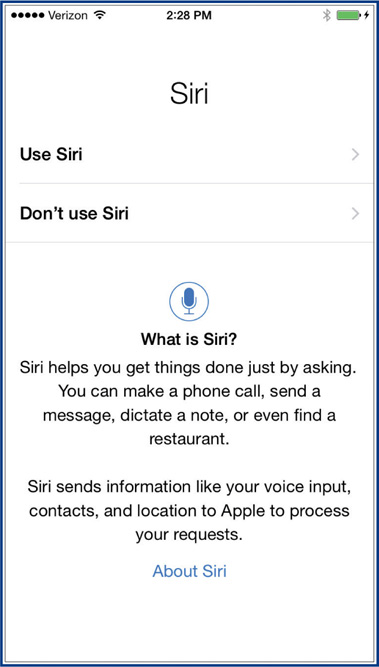
21. You can choose to help Apple by anonymously sending them information about how you are using your iPhone, including your location. I believe that doing this helps all users, so I recommend it. If you agree, tap Automatically Send; if not, tap Don’t Send. In either case, tap Next.
22. Similarly, you are asked if you want to help app developers by having Apple share crash information and data about how you use apps with them. Again, I think this is worthwhile and recommend that you do it. If you agree, tap Share With App Developers; if not, tap Don’t Share.
23. If you want larger images and text on the screen, tap Zoomed; otherwise, tap Standard. You are shown the image you have chosen. If you want to change it, tap the opposite at the top of the screen. When you are ready, tap Next.
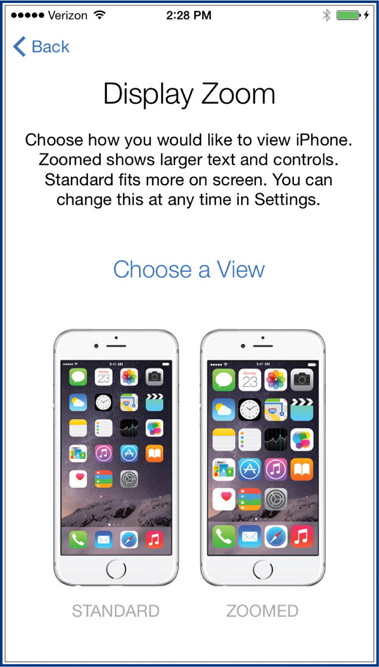
24. Finally, you see “Welcome to iPhone.” Tap Get Started. The familiar iPhone Home page is displayed.

![]() QuickFacts
QuickFacts
Using the Onscreen Keyboard
When you need to enter text on your iPhone, an onscreen keyboard is automatically displayed. Simply tap the keys you want to use. Here is how to use the other features of the onscreen keyboard:

• If you don’t see a keyboard when a form or text entry box is displayed, simply tap in the text box in which you want to place text.
• To make a letter uppercase, press the upward-pointing arrow or the SHIFT key so the arrow itself darkens, and then tap the letter. Uppercase will automatically be turned off after you tap the letter.
• To make a series of letters uppercase, double-tap (tap twice in rapid succession) the SHIFT key so a line appears beneath the arrow. Then tap the keys you want in uppercase. When you are done, tap the upward-pointing arrow again to turn it off.

• To correct an error, tap the BACKSPACE key once for each letter you want to replace. Then tap the replacement key(s).

• To complete one line of type and go to the next line, tap the RETURN key. You may also tap the new line on the screen.
• To enter numbers and some of the special characters, tap the 123 key. If you don’t see the special characters you want, tap the #+= key for additional characters. When you are done entering numbers and/or special characters, tap the ABC key to return to the original keyboard.

• With the ! and ? keys, press and hold the key for a moment to see two options and then press the desired key to get the character you want. There are also a number of additional choices by tapping and holding any of these keys: - / $ &”. and’.
![]()
• When you finish entering text or complete a form, the onscreen keyboard automatically disappears.
 Attach Your iPhone to a Computer
Attach Your iPhone to a Computer
If you have a recent (in the last five years) computer available to you, either a Mac or a PC, you can attach your iPhone to it and transfer information between the two devices. To do that, you need to install Apple’s iTunes on that computer if you haven’t already. This is a particularly good approach if you have a lot of music or videos on the computer that you want on the iPhone. See the “Reviewing What You Need” QuickFacts earlier in this chapter for the specifications of the computer you need to use.
If you have iTunes already on the computer, make sure it is up to date. On a Mac, press the Apple key and click Software Update. On a PC with Windows 7 or earlier, click Start, click All Programs, and click Apple Software Update. On a Windows 8 PC, on the Start screen, start typing Apple and click Apple Software Update. You will be told if iTunes is not up to date. If so, follow the instructions to update it.
Download and Install iTunes
If you do not already have iTunes, you can download it for free from Apple and install it on your computer.
![]()
TIP You do not have to use a credit card to set up an iTunes account. Simply select None or skip the entry when you are asked for a payment type. You, of course, will not be able to buy anything that’s not free (there are many free items on both the App Store and iTunes Store). Also, you can get a very limited credit card and use that for your Apple ID and other purchases on the Internet.
1. On your computer, open a browser, type itunes.com in the address box and press ENTER. The Apple iTunes download page will open.
2. Click Download iTunes. On the next page, click Download Now (you don’t have to enter your email address, and I’d uncheck the two email offers) and click Run at the bottom of the screen in Windows 7 and earlier versions or click itunes64Setup.exe at the bottom of the window in Windows 8.
3. In the Welcome To iTunes dialog box that opens, click Next. Uncheck any of the options you don’t want, and then click Install and click Yes to allow iTunes to make changes to your computer.
4. Finally, when you are told that iTunes has been installed, click Finish. iTunes will open on your desktop.
Connect Your iPhone to iTunes
Once you have iTunes installed and your iPhone set up, it is time to connect the two. Here are the steps to follow:
1. Plug the Apple Lightning connector into your iPhone and the USB connector into your computer. The iPhone’s screen will come on. Touch the Touch ID or swipe the Slide To Unlock arrow left to right and enter your passcode, if you have enabled either of these, and then tap Trust in the Trust This Computer? dialog box that opens.
2. If it isn’t already running on your computer, start iTunes. You should see your iPhone appear in the left column. If you don’t have a left column (or sidebar), click the View menu and click Show Sidebar. If you don’t see a menu bar across the top, click the Select menu (the black and white rectangle) in the far upper-left corner, and then click Show Menu Bar.
3. Click your iPhone in the left column to open a pane on the right about your iPhone, as you see in Figure 1-2.
Figure 1-2: iTunes not only allows you to transfer information, but also to control some aspects of your iPhone.
4. If you had a previous iPhone that you backed up, you can restore it now by selecting that option and jumping to step 6. Alternatively, you can set up as a new iPhone (if you didn’t previously have an iPhone or back it up, that is the automatic selection). Click Continue.
5. You are told you can sync the music on your computer through iTunes to your iPhone. Click Get Started.
6. If, when you set up your iPhone as described earlier in the chapter, you selected to automatically back up on iCloud, it will be selected in iTunes, as you see in Figure 1-3.
Figure 1-3: iTunes allows you to perform several operations on your iPhone remotely.
7. You may additionally, or in lieu of iCloud, back up on the computer you are connected to. If so, click that option, if desired, click Encrypt Local Backup, enter and verify a password, and click Back Up Now.
You will see a lot more about syncing music, videos, and other media between iTunes and your iPhone in later chapters of this book.
![]()
NOTE Although you can back up your iPhone to a computer, I recommend additionally, or in lieu of the computer, backing up to iCloud. The computer can be destroyed by fire or be stolen; the iCloud cannot be. If you choose to back up both to your computer and to iCloud, I recommend that you leave iCloud selected for automatic backup and manually back up to your computer.
 Turn Your iPhone On or Off and Put It to Sleep or Wake It
Turn Your iPhone On or Off and Put It to Sleep or Wake It
In going through the setup of your iPhone, you have probably experienced the screen shutting itself off automatically after the iPhone had been inactive for a period of time. This is the iPhone’s sleep mode, a low-power condition that prolongs the battery life, but makes it immediately available to perform some task for you. This is one of three power modes:
• Fully powered on with the screen lit and the iPhone is available at a single touch.
• In sleep mode with the screen dark, but the iPhone is available by waking it.
• Fully powered off and not using any power. It must be turned on to be used.
Turn the iPhone On or Off
When the iPhone is fully powered off, you must start it up. You know it is off if you press the Home key and nothing happens (given that your battery has a charge).
• To turn off your iPhone, press and hold the On/Off–Sleep/Wake button until the Power Off command appears, and then swipe that command from left to right.
• To turn on your iPhone, press and hold the On/Off–Sleep/Wake button until the Apple icon appears. Then, when the Slide To Unlock command appears, swipe it from left to right. Enter your passcode. Even if you are using Touch ID, you must enter a passcode when starting up.
Put Your iPhone to Sleep or Wake It
By providing the sleep mode, Apple has made your battery last a lot longer. Remember that when you get tired of your iPhone often being asleep. You can adjust the period of time before your iPhone goes to sleep, as you will see in Chapter 2.
You can wake your iPhone in two ways:
• Press the Home button and either swipe the Slide To Unlock command from left to right, and enter your passcode, or touch the Home button to use Touch ID.
• Press the On/Off–Sleep/Wake button and either swipe the Slide To Unlock command from left to right and enter your passcode, or touch your Home button to use Touch ID.
To put your iPhone to sleep, momentarily press the On/Off–Sleep/Wake button. (Normally, your iPhone will go to sleep automatically, but if you want, you can put it to sleep manually.)
 Get Accessories for Your iPhone
Get Accessories for Your iPhone
A large number of accessories are available for your iPhone from both Apple (apple.com/us/iPhone/iphone-accessories) and retailers such as Amazon (go to Amazon.com and search for “iPhone accessories”). Some of the accessories you can consider include cases and covers, screen protectors, cables, and headphones.

